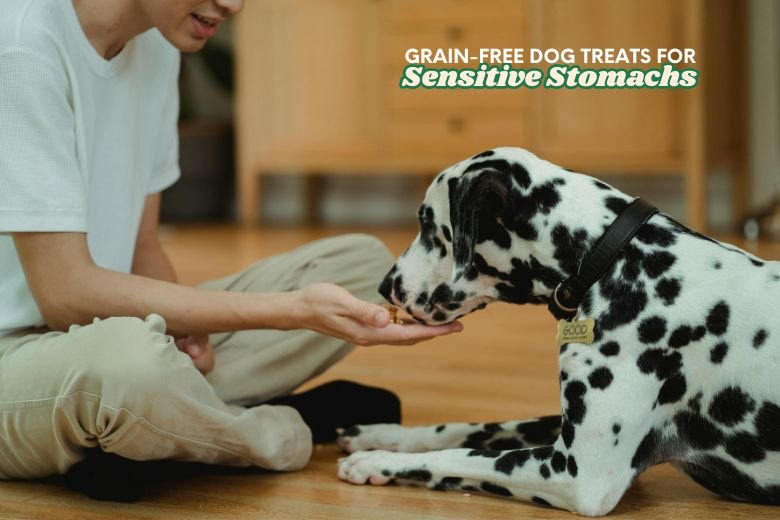Grain-free dog treats for sensitive stomachs are a great way to keep your pup happy and healthy without triggering digestive issues. These treats avoid grains like wheat and corn, using alternative ingredients to support dogs with food sensitivities.
Introduction: Why Grain-Free Dog Treats Matter for Your Pup
Have you ever watched your dog gobble up a treat, only to see them struggle with an upset stomach hours later? It’s heartbreaking to see your furry friend in discomfort. For dogs with sensitive stomachs, finding the right treats can feel like a treasure hunt. That’s where grain-free dog treats for sensitive stomachs come in—a game-changer for pups prone to digestive woes. These treats skip grains like wheat, corn, or barley, which can irritate some dogs’ stomachs, and instead use gentle, wholesome ingredients. In this guide, we’ll explore why grain-free treats are a smart choice, how to pick the best ones, and even how to make your own at home. Let’s dive in and help your dog feel their best!
Why Do Some Dogs Have Sensitive Stomachs?
Sensitive stomachs in dogs can stem from various causes, from food allergies to digestive disorders. Grains, in particular, can be tough for some pups to process. According to a 2023 study by the American Kennel Club, about 10% of dogs experience food sensitivities, with grains being a common trigger. Grain-free dog treats for sensitive stomachs are designed to avoid these irritants, using ingredients like sweet potatoes or chickpeas instead.
Common Signs of a Sensitive Stomach
- Vomiting or diarrhea after eating
- Excessive gas or bloating
- Lack of appetite or picky eating
- Itchy skin or ear infections (linked to food sensitivities)
If your dog shows these signs, grain-free treats might be worth trying. Always consult your vet to rule out underlying health issues.
Benefits of Grain-Free Dog Treats
Switching to grain-free dog treats for sensitive stomachs offers several perks, especially for dogs with dietary sensitivities. Here’s why they’re a great choice:
- Easier Digestion: Ingredients like pumpkin or coconut flour are gentler on the stomach than wheat or corn.
- Fewer Allergens: Grain-free treats often avoid common allergens, reducing the risk of reactions.
- Nutrient-Rich: Many grain-free treats include high-quality proteins and veggies, supporting overall health.
- Tasty Variety: From crunchy biscuits to soft chews, there’s something for every pup.
For example, brands like Zuke’s Mini Naturals use grain-free ingredients like peanut butter and chickpeas, offering a tasty, stomach-friendly option.
Key Ingredients to Look for in Grain-Free Treats
Not all grain-free treats are created equal. The best grain-free dog treats for sensitive stomachs use high-quality, easy-to-digest ingredients. Here’s what to prioritize:
- Single-Source Proteins: Chicken, turkey, or salmon to minimize allergen exposure.
- Alternative Carbs: Sweet potato, lentils, or peas instead of grains.
- Natural Fibers: Pumpkin or flaxseed to support digestion.
- No Artificial Additives: Avoid artificial colors, flavors, or preservatives that could upset your dog’s stomach.
For instance, Blue Buffalo’s Basics Limited Ingredient Treats focus on one protein and one carb, making them ideal for sensitive pups.
Ingredients to Avoid in Dog Treats
While grain-free treats are a great start, some ingredients can still cause trouble for dogs with sensitive stomachs. Steer clear of:
- Fillers: Corn, soy, or wheat gluten can irritate digestion.
- Artificial Preservatives: Look out for BHA, BHT, or ethoxyquin.
- High-Fat Ingredients: Excessive fat can trigger pancreatitis in sensitive dogs.
- Dairy: Some dogs are lactose intolerant, so skip treats with cheese or milk.
Always check the label to ensure the treats align with your dog’s needs.
How to Choose the Best Grain-Free Dog Treats
Picking the right grain-free dog treats for sensitive stomachs involves more than just grabbing a bag off the shelf. Here are some tips to guide you:
- Read the Ingredient List: Look for short, recognizable ingredient lists with whole foods.
- Check for Limited Ingredients: Fewer ingredients reduce the chance of triggering sensitivities.
- Consider Texture: Soft treats are easier for some dogs to digest, while crunchy ones help with dental health.
- Look for Vet Approval: Brands like Hill’s Science Diet often carry vet-recommended options.
- Test Small Batches: Buy a small pack to ensure your dog tolerates the treat before committing.
For example, Wellness Core Grain-Free Treats use turkey and pomegranate, offering a balance of flavor and digestibility.
Homemade Grain-Free Dog Treats: A Simple Recipe
Want to control exactly what goes into your dog’s treats? Making grain-free dog treats for sensitive stomachs at home is easier than you think. Here’s a quick recipe:
Pumpkin & Peanut Butter Bites
Ingredients:
- 1 cup canned pumpkin (pure, unsweetened)
- ½ cup natural peanut butter (xylitol-free)
- 1 ½ cups coconut flour
- 1 egg
Instructions:
- Preheat oven to 350°F.
- Mix pumpkin, peanut butter, and egg in a bowl until smooth.
- Gradually add coconut flour until a dough forms.
- Roll dough into small balls and flatten into discs.
- Bake for 20–25 minutes until golden. Cool before serving.
This recipe is gentle on stomachs and packed with fiber from pumpkin. Learn more about homemade dog treats here.
Are Grain-Free Treats Safe for All Dogs?
Grain-free diets have sparked debate, with some linking them to heart issues like DCM (dilated cardiomyopathy). However, the FDA’s 2020 report found no definitive link, especially for treats used in moderation. Grain-free dog treats for sensitive stomachs are generally safe for dogs with confirmed grain sensitivities, but consult your vet if your dog has other health concerns.
When to Avoid Grain-Free Treats
- If your dog has no grain sensitivities, whole-grain treats may offer more fiber.
- Dogs with specific medical conditions may need tailored diets.
Always introduce new treats gradually to monitor your dog’s reaction.
How to Transition Your Dog to Grain-Free Treats
Switching to grain-free dog treats for sensitive stomachs requires a slow approach to avoid digestive upset. Follow these steps:
- Start Small: Offer one small treat and monitor for 24 hours.
- Mix with Old Treats: Gradually replace old treats with grain-free ones over 7–10 days.
- Watch for Reactions: Look for signs of improved digestion or new issues.
- Consult Your Vet: If your dog has chronic issues, get professional advice.
This gradual transition helps your dog adjust without stress.
Top Brands for Grain-Free Dog Treats
Several brands excel at making grain-free dog treats for sensitive stomachs. Here are some top picks based on quality and reviews:
- Zuke’s Mini Naturals: Small, soft treats with single-source proteins.
- Blue Buffalo Basics: Limited-ingredient treats for sensitive dogs.
- Wellness Core: High-protein, grain-free options with natural ingredients.
- Merrick Power Bites: Soft, chewy treats with real meat as the first ingredient.
Check out our guide to dog treat brands for more details.
Can Grain-Free Treats Help with Other Health Issues?
Beyond sensitive stomachs, grain-free dog treats for sensitive stomachs may help with other conditions:
- Skin Allergies: Grain-free treats can reduce itching caused by food sensitivities.
- Weight Management: Many grain-free treats are lower in carbs, aiding weight control.
- Joint Health: Some include glucosamine or chondroitin for joint support.
For example, treats like Nulo Freestyle Grain-Free use salmon and turmeric, which may reduce inflammation.
Grain-Free Dog Treats – Frequently Asked Questions
What are grain-free dog treats for sensitive stomachs?
These are treats made without grains like wheat, corn, or barley, designed to be gentle on dogs with digestive sensitivities. They often use alternative carbs like sweet potatoes. See ingredients to look for.
Are grain-free treats better for dogs with sensitive stomachs?
For dogs with grain sensitivities, yes. They reduce the risk of digestive upset. However, not all dogs need grain-free diets, so consult your vet. Learn more about safety.
How do I know if my dog has a sensitive stomach?
Signs include vomiting, diarrhea, gas, or picky eating after meals. A vet can confirm food sensitivities. See signs of sensitive stomachs.
Can I make grain-free treats at home?
Absolutely! Simple recipes like pumpkin and peanut butter bites are safe and easy. Check out our recipe.
Are grain-free treats more expensive?
They can be pricier due to high-quality ingredients, but affordable options like Zuke’s exist. Compare brands for budget-friendly choices. See top brands.
How often can I give my dog grain-free treats?
Treats should make up no more than 10% of your dog’s daily calories. Check portion guidelines on the package or consult your vet.
Conclusion: Happy Pups, Happy Tummies
Choosing grain-free dog treats for sensitive stomachs can make a world of difference for your dog’s comfort and happiness. By focusing on high-quality ingredients, avoiding triggers, and transitioning slowly, you can find or make treats that keep your pup’s tail wagging. Whether you opt for trusted brands or whip up a batch at home, your dog will thank you for the tummy-friendly goodies. Have a favorite grain-free treat recipe? Share it with us, or explore our guide to dog nutrition for more tips!




